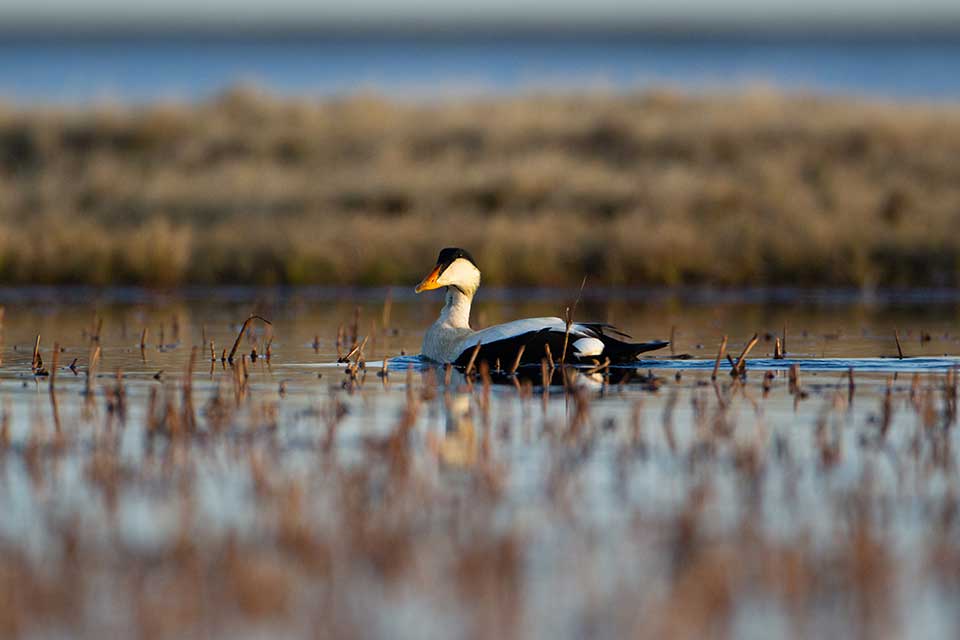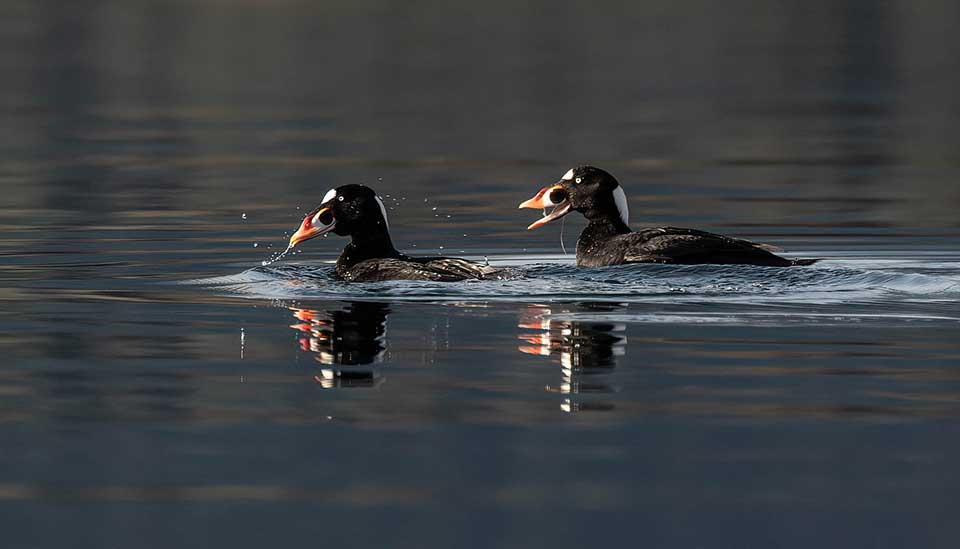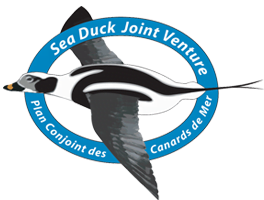
Black Scoter at Izembek NWR, Photo: Kristine Sowl, USFWS
We’re thrilled to announce our 2024 Research Projects, a group of five research projects submitted as part of our annual RFP. The Sea Duck Joint Venture aims to fund projects that will provide information on sea duck migratory connectivity, habitat use, and population size, incorporate Indigenous Knowledge, and/or seek to determine the impact of anthropogenic activities, harvest, climate change, predators, or disease on sea duck populations. The ultimate goal is to support projects that will improve the ability of managers to make informed decisions about sea duck conservation.
The five projects funded this year are:

Common Eider, Photo: Peter Pearsall, USFWS
Led by partners at Nunatsiavut Government, Acadia University, Canadian Wildlife Service, Ducks Unlimited Canada, Environment and Climate Change Canada, this project aims to deploy satellite transmitters on up to 25 Common Eiders, measure contaminant levels, and integrate Indigenous knowledge and scientific data to understand the species’ migratory patterns, habitat use, and risks to improve sea duck conservation and management.
This research builds upon previous and ongoing studies and will improve understanding of the relationship between Labrador eiders and wintering areas in the USA. It also supports the Nunatsiavut Government’s efforts to conserve a culturally significant species and fosters collaboration in eider management. Additionally, community engagement and participatory mapping will ensure that Indigenous knowledge is incorporated into both study planning and interpretation of our findings, enhancing local and scientific understanding of the Common Eider’s importance, and informing marine conservation efforts in the region.
For most of their annual cycle, North American sea ducks are densely distributed in estuaries and along the coastal nearshore where they are susceptible to oil spills, energy development, changing ocean conditions, and other potential threats. Observer-based aerial surveys have been an important tool for understanding sea ducks’ responses to their changing environment. However, safety, expense, observer bias and lack of methodological consistency are rising concerns associated with observer-based surveys, making it imperative to transition to more sustainable methods. Digital aerial surveys (DAS) that automate counts from aerial imagery using convolutional neural network (CNN) models are one way to improve survey safety and count accuracy.
This project led by the USGS Western Ecological Research Center, Washington Department of Fish and Wildlife, and Canadian Wildlife Service aims to develop a standardized DAS for the lower Pacific Flyway to help maximize safety while improving data consistency and model accuracy among important regions within the Flyway. To do this, they will collect Pacific Coast sea duck imagery and retrain existing models to create a sea duck-specific model. To test it, they will then conduct digital aerial surveys at two Sea Duck Key Habitat Sites, the Salish Sea, and San Francisco Bay, to quantify sea duck abundance and species composition.
The exposure of marine birds to acute and chronic oil pollution has widespread impacts, including direct mortality as well as a variety of sub-lethal effects such as reduced breeding success and increased physiological stress. These oil-related impacts are due to the toxicity of various substances within oil and gas, notably polycyclic aromatic compounds (PACs). Declining populations of Common Eiders in Atlantic Canada are exposed to a wide range of anthropogenic activities with associated oil-related pollution, but baseline levels of PACs are unknown. Quantifying contaminant loads throughout their breeding range is important for understanding exposure and impacts to the species, but also integral understanding to food safety for Inuit and First Nations in the region who consume eiders and their eggs. Initial studies of PACs in eider eggs from northern Labrador have led to recommendations on limitations to monthly consumption.
Led by the University of Manitoba, Environment and Climate Change Canada, and Canadian Wildlife Service, this project will quantify PAC concentrations in Common Eider eggs across 18 breeding sites in eastern Canada, including Labrador, Newfoundland, the Gulf of St. Lawrence, the Scotian Shelf, and the Bay of Fundy (Gulf of Maine). These results will form baselines against which managers can quantify impacts, long-term trends, and recovery from oil-related pollution.

Surf Scoters, Photo: Deborah Freeman, Creative Commons
SDJV # 175: What are the ducks telling us? Documenting K’ahsho Got’ine knowledge about scoters
Managed by partners at Fort Good Hope Renewable Resources Council, Tuyeta Management Board, K’ahsho Got’ine Foundation, Canadian Wildlife Service, and Environment and Climate Change Canada, this project aims to work together to develop and implement an Indigenous Knowledge survey related to areas historically used by priority sea duck species Surf Scoter and White-winged Scoter during spring and summer and evaluate current use of these areas by scoters through ground-based surveys.
The proposed study will build a much-needed foundation for Indigenous partnerships and expansion of similar projects to other geographic areas in North America where sea ducks constitute an important component of subsistence harvesting and traditional ways of life.
Sea duck demographic parameters are difficult for researchers to estimate at a range-wide scale because their breeding and wintering areas are challenging to access and/or work in. Recent population modeling has provided insight into which demographic parameters are most important for better understanding the harvest potential of these species, hence improving management, and providing a sustainable recreational opportunity.
This project led by researchers at Pennsylvania State University and USFWS aims to use population models integrated with Christmas Bird Count trend data and demographic parameter estimates to improve estimates of annual survival, estimate the effect of changing harvest regulations on survival, and provide insight into what data needs are most useful for improving demographic rate estimates. The target species of this study are the Black Scoter, Surf Scoter, and White-winged Scoter in eastern North America.
